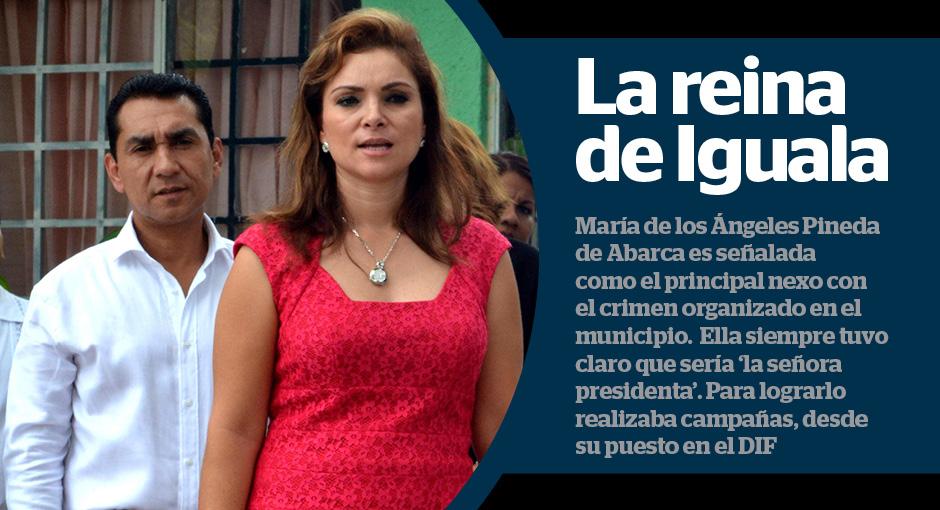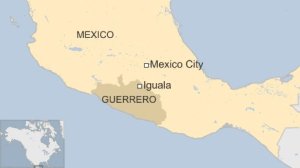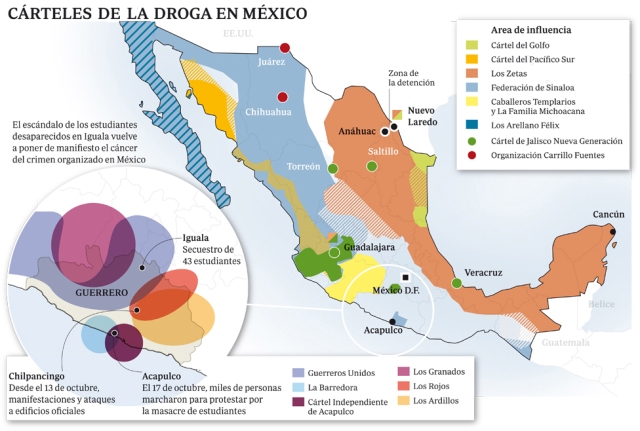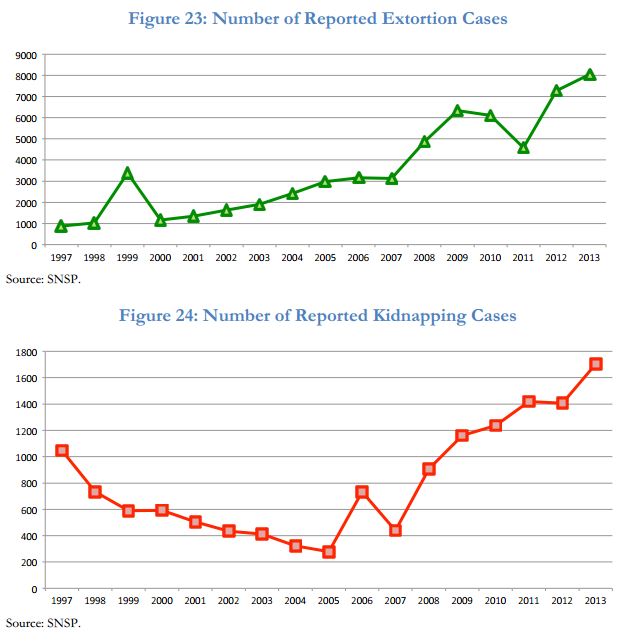
Things Fall Apart – Iguala Interrupts Mexico’s Moment
It only took one month for Mexico to go from model student to failed state. The media is fickle that way. But, the events in Iguala have only highlighted a reality that has persisted in Mexico for several years now (and worsened). I don’t know who was drinking whose Kool-Aid: was EPN convincing the journalists that Mexico had changed because he focused on structural reforms; or did the media’s love affair with the Pacto convince EPN that he was bulletproof? Either way, both are at fault.
What Happened in Iguala?
On September 26, student teachers from the Ayotzinapa Normal School in Guerrero state (normalistas) traveled by bus to the nearby city of Iguala, apparently to obtain three buses for transportation to surrounding towns for their studies and to Mexico City on October 2. Around 9:30 PM, the students were passing through central Iguala in three buses stolen from the bus station, when municipal police attacked them. Two to three hours later, police and members of Guerreros Unidos, a local criminal gang, opened fire on a group of the students who were protesting what had happened earlier. Some time later, a bus carrying the Avispones de Chilpancingo – a division 3 soccer team – was attacked on the Iguala-Chilpancingo highway. The aftermath: six dead; 17 injured; 43 missing.
Around 9:30 PM, the students were passing through central Iguala in three buses stolen from the bus station, when municipal police attacked them. Two to three hours later, police and members of Guerreros Unidos, a local criminal gang, opened fire on a group of the students who were protesting what had happened earlier. Some time later, a bus carrying the Avispones de Chilpancingo – a division 3 soccer team – was attacked on the Iguala-Chilpancingo highway. The aftermath: six dead; 17 injured; 43 missing.
 Around 9:30 PM, the students were passing through central Iguala in three buses stolen from the bus station, when municipal police attacked them. Two to three hours later, police and members of Guerreros Unidos, a local criminal gang, opened fire on a group of the students who were protesting what had happened earlier. Some time later, a bus carrying the Avispones de Chilpancingo – a division 3 soccer team – was attacked on the Iguala-Chilpancingo highway. The aftermath: six dead; 17 injured; 43 missing.
Around 9:30 PM, the students were passing through central Iguala in three buses stolen from the bus station, when municipal police attacked them. Two to three hours later, police and members of Guerreros Unidos, a local criminal gang, opened fire on a group of the students who were protesting what had happened earlier. Some time later, a bus carrying the Avispones de Chilpancingo – a division 3 soccer team – was attacked on the Iguala-Chilpancingo highway. The aftermath: six dead; 17 injured; 43 missing.
The Mayor’s Wife is a Drug Kingpin
The Mayor of Iguala, Jose Luis Abarca, and his wife, Maria de los Angeles Pineda Villa, fled shortly after the events. The Mexican Attorney General (PGR) then announced that Abarca and Pineda were the ‘intellectual authors’ of the massacre. Why? One account has it that Pineda was giving a speech at the central Plaza of Zocalo when she was told some ‘outsiders’ were approaching. That’s when she told police to ‘teach the kids a lesson’. But the normalistas deny ever approaching the square, although they did drive by it.
Why? One account has it that Pineda was giving a speech at the central Plaza of Zocalo when she was told some ‘outsiders’ were approaching. That’s when she told police to ‘teach the kids a lesson’. But the normalistas deny ever approaching the square, although they did drive by it.
 Why? One account has it that Pineda was giving a speech at the central Plaza of Zocalo when she was told some ‘outsiders’ were approaching. That’s when she told police to ‘teach the kids a lesson’. But the normalistas deny ever approaching the square, although they did drive by it.
Why? One account has it that Pineda was giving a speech at the central Plaza of Zocalo when she was told some ‘outsiders’ were approaching. That’s when she told police to ‘teach the kids a lesson’. But the normalistas deny ever approaching the square, although they did drive by it.
More important, Pineda is the head of a criminal drug enterprise – i.e., the Guerreros Unidos mentioned above – that split off from the now-defunct Beltran-Leyva Cartel. And it’s not like she changed her name and dyed her hair – everyone kind of knew who she was. There’s even a blog from 2012 that makes all these accusations in great detail, including that Pineda financed the campaign of Abarca and Guerrero Governor Angel Aguirre. Not only is that true, but it also turns out that Pineda had a romantic relationship with Gov. Aguirre. Even worse, Abarca has allegedly done this before: in 2013, when three protesters were killed out of eight kidnapped.
It Gets Worse
After the story broke and the first couple of Iguala fled, the federal government launched an investigation with the following results so far:
- Federal police took over Iguala and disarmed the local police
- Federal police made a bunch of arrests
- Gov. Aguirre resigned, but his replacement is an alleged former member of the FARC guerrillas in Colombia
- An interim mayor was appointed, but he quit within hours after taking up his post
- Search parties identified 11 unmarked graves with 38 bodies, but none containing the remains of the 43 missing students
- EPN has not visited Iguala or delivered a ‘State of the Union’ style speech, just a brief announcement (see video below)
- Government investigators still have not found the students
Were Normalistas Involved with Narcos?
On Thursday, October 16, Federal Police apprehended another leader of Guerreros Unidos, Sidronio Casarrubias Salgado ‘on a highway outside Mexico City’. Casarrubias, who also goes by Santiago Jaurer Cadena, is a ghost online: nothing shows up for either name prior to his capture. Federal investigators questioned Casarrubias, and he had a different version of events from that night.
According to Casarrubias, 17 members of Los Rojos, a rival criminal gang at war withGuerreros Unidos, had ‘infiltrated’ the normalistas and were on the buses that came to Iguala. The purpose was to discretely enter Iguala and assassinate the Benitez Palacios brothers, also of Guerreros Unidos. Casarrubias indicated that he understands – he wasn’t present – that members of the Guerreros Unidos were able to locate and capture the infiltrators, but denied that his men took the students. Interestingly, Casarrubia’s timeline of events starts at midday on September 26, although it is otherwise undisputed that the students arrived at night. Most commentators in Mexico have dismissed Casarrubia’s version.
On October 31, a Guerreros Unidos member – ‘Corporal Gil’ – with whom Cassrrubia is in contact claimed that the normalistas are still alive and that Guerreros Unidos is prepared to return them in exchange for the federal government detaining 80 percent of a criminal group comprised of mayors in norther Guerrero and southern Morelos.
Who are the Normalistas?
Normal Schools are a collection of rural institutions set up during the 1920s right after the revolution. The idea of a Normal School is to serve the socioeconomic needs of the region. The students come from extreme poverty and will train to be teachers in the communities from which they came. The students do not pay tuition or board, and in principle the government supplies food and other items as well.
Over time, the Normal Schools have evolved into incubators of radical – usually Marxist – politics. At the same time, the federal and state governments have slashed funding for the Normal School system. The students of Normal Schools are known for their aggressive tactics to convey political messages – the main one being that they do not have enough funding.
These tactics include blocking highways, commandeering buses, and stealing gas (thisaccount from inside the Ayotzinapa school provides a good account of their thinking). Sometimes, this leads to violence. Indeed, the night of the incident in Iguala, the students apparently injured a car wash attendant while passing through town. In 2011, policekilled two students from the same school in skirmishes when the students blocked a highway.
gas (thisaccount from inside the Ayotzinapa school provides a good account of their thinking). Sometimes, this leads to violence. Indeed, the night of the incident in Iguala, the students apparently injured a car wash attendant while passing through town. In 2011, policekilled two students from the same school in skirmishes when the students blocked a highway.
 gas (thisaccount from inside the Ayotzinapa school provides a good account of their thinking). Sometimes, this leads to violence. Indeed, the night of the incident in Iguala, the students apparently injured a car wash attendant while passing through town. In 2011, policekilled two students from the same school in skirmishes when the students blocked a highway.
gas (thisaccount from inside the Ayotzinapa school provides a good account of their thinking). Sometimes, this leads to violence. Indeed, the night of the incident in Iguala, the students apparently injured a car wash attendant while passing through town. In 2011, policekilled two students from the same school in skirmishes when the students blocked a highway.
There is a lot of public sympathy for the normalistas right now. But before September 26 they were not well-liked by people in Guerrero. Some of the animosity came from their ‘political’ tactics. But, it is also well-known in Guerrero that Normal Schools historically have served as an intellectual training ground for guerrilla movements in the region. One of these groups – the Insurgent People’s Revolutionary Army (EPRI) – announcedthe creation of a brigade dedicated to punishing those responsible for harming the EPRI’s ‘normalista comrades’.
Pot Boils Over in Guerrero
The Iguala event represents the most dramatic expression to date of several forces that have been brewing for some time in states like Guerrero. The basic recipe is extreme poverty, an ideal geography for drug trafficking, and non-existent rule of law.
But many argue that the immediate cause was the Calderon administration’s strategy in their war on the cartels. Calderon focused on taking out high profile members of the leadership in the eight major cartels at the time. And they were successful. But the ‘perverse effect’ was to encourage mid-level cartel members to splinter off and form their own independent groups, as the map below illustrates.
These new, smaller gangs engage in open warfare more often than the larger cartels of before. Also, they have expanded downwards into more ‘ordinary’ crimes likekidnapping, extortion, robbery, etc. Guerrero is home to six of these smaller gangs:
(see more impressive map)
When the former members of the large cartels splintered off into smaller factions and focused their efforts on non-drug revenue sources, in some cases the lives of ordinary people got worse. Again, kidnapping and extortion are the biggest sources of concern (Source: Drug Violence in Mexico):
So violence has both worsened and impacted regular citizens more directly, and as the Iguala case illustrates: the government/police are not there to help. Most people in regions like Guerrero cannot move because they lack the resources. Thus, poverty, violence, and non-functional state = irregular, quasi-state organizations.
Autodefensas and Guerrillas
Most famous have been the rise of so-called ‘community’ police or self-defense organizations (autodefensas). At first, people welcomed such groups because they took on the cartels and guerrillas. But after some time, they began to engage in the same extortionate practices. In some cases, they even allegedly entered the drug trade or were created by cartels as a ‘legitimate’ way to wage war on rivals. Currently, Guerrero hasseven autodefensa groups:
Guerrero is also home to eight guerrilla groups:
- Ejército Popular Revolucionario (EPR)
- Ejército Revolucionario del Pueblo Insurgente (ERPI)
- Movimiento Revolucionario Lucio Cabañas Barrientos
- Movimiento Armado Revolucionario Ricardo Flores Magón
- Milicias Insurgentes Ricardo Flores Magón (MIRFM)
- Ejército Revolucionario de Insurgencia Popular (ERIP)
- Ejército Popular Magonista de Liberacion Nacional (EPM-LN)
- Fuerzas Armadas Revolucionarias del Pueblo (FARP)
The events in Iguala have seemingly ‘awoken‘ these groups, which had been dormant for over a decade until now.
A Failure of State-Making
As you can see, the Mexican southwest is a lot like the pre-Civil War western territories of the U.S. (i.e., the ‘Wild West’). Why? The Mexican government is lying in the bed it itself made over 70 years of corporatist PRI rule. Under that system, the PRI avoided challenges to its hegemony by organizing society into corporate ‘sectors’ through massive official organizations. The PRI could address concerns of these sectors through these groups and by doling out benefits via its control over most of the economy. Most people got what they wanted from this arrangement, and the development of organic civil society was stunted.
Then, the PRI system – and benefits from state-controlled economy – receded. But no institutions remained allowing citizens to self-organize and express demands to government. This was worse in the impoverished rural areas, which also happen to be ideal for cultivating and transshipping drugs. So, the cartels stepped in and replaced the PRI as patrons to the community, buying loyalty with cash. And the autodefensas stepped in to provide security.
What Should Mexico Do?
The entire state and local government apparatus is not trustworthy – this is not a matter of voting in better people next time. Guerrero requires a sustained federal military/police presence in the foreseeable future. There are already several military installations near Iguala – some of the normalistas tried to get help at one – but I’m referring to a force that is trained in military-civilian relations and acts like a police force.
The other piece is a new institution aimed at identifying and punishing those who have participated in past atrocities. Guerrero already has a truth commission, but this would be something with a broader mandate. As a model, Mexico could use the International Commission against Impunity in Guatemala. The UN created the CICIG in 2007 at Guatemala’s request. Its mandate was threefold:
- Investigate existence of illicit armed forces
- Assist in the prosecution of individuals involved
- Help build capacity with local institutions for when CICIG’s mandate expires
By 2010, the CICIG had helped get rid of thousands of corrupt police, ten prosecutors, three supreme court judges, and an attorney general. CICIG also supported Guatemalan prosecutors with the trial and conviction of 130 criminals (e.g., a former President). The CICIG has been controversial – alternately accused of overstepping and holding back. Still, its successes by far outnumber its failures.
Mexico cannot rely on its existing institutions to solve the problems in states like Guerrero. Even the federal authorities often collude with local criminals – e.g., one of the late brothers of Pineda paid federal prosecutors USD 450K per month in exchange for information on their investigations. Mexico needs a new institution like the CICIG to cleanse institutions and bring closure to the families of the disappeared.




No comments:
Post a Comment